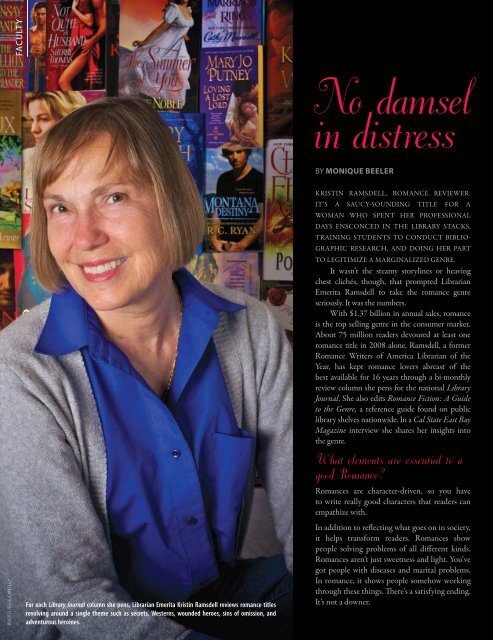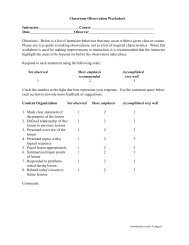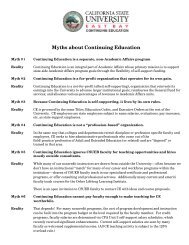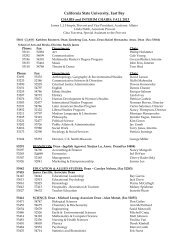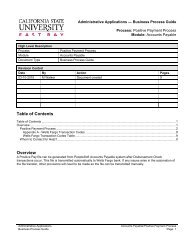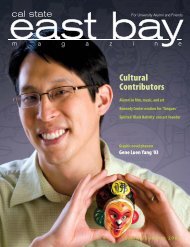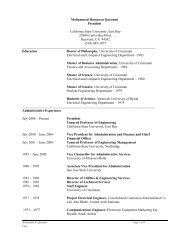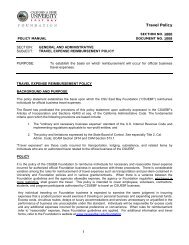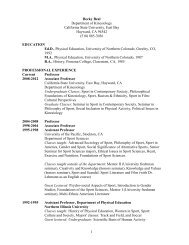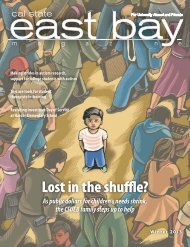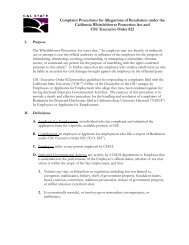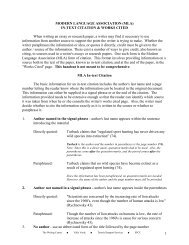Fall 2010 - California State University, East Bay
Fall 2010 - California State University, East Bay
Fall 2010 - California State University, East Bay
You also want an ePaper? Increase the reach of your titles
YUMPU automatically turns print PDFs into web optimized ePapers that Google loves.
PHOTO JESSE CANTLEY<br />
faculty<br />
No damsel<br />
in distress<br />
BY Monique Beeler<br />
Kristin Ramsdell, romance reviewer.<br />
It’s a saucy-sounding title for a<br />
woman who spent her professional<br />
days ensconced in the library stacks,<br />
training students to conduct bibliographic<br />
research, and doing her part<br />
to legitimize a marginalized genre.<br />
It wasn’t the steamy storylines or heaving<br />
chest clichés, though, that prompted Librarian<br />
Emerita Ramsdell to take the romance genre<br />
seriously. It was the numbers.<br />
With $1.37 billion in annual sales, romance<br />
is the top selling genre in the consumer market.<br />
About 75 million readers devoured at least one<br />
romance title in 2008 alone. Ramsdell, a former<br />
Romance Writers of America Librarian of the<br />
Year, has kept romance lovers abreast of the<br />
best available for 16 years through a bi-monthly<br />
review column she pens for the national Library<br />
Journal. She also edits Romance Fiction: A Guide<br />
to the Genre, a reference guide found on public<br />
library shelves nationwide. In a Cal <strong>State</strong> <strong>East</strong> <strong>Bay</strong><br />
Magazine interview she shares her insights into<br />
the genre.<br />
What elements are essential to a<br />
good Romance<br />
Romances are character-driven, so you have<br />
to write really good characters that readers can<br />
empathize with.<br />
Who reads your Library Journal column<br />
It’s a review column to educate librarians on what romance fiction<br />
is and all the different authors.<br />
I only review (books) that are published the month the column<br />
comes out or after. The range would be 18 to 24 books reviewed<br />
per column.<br />
Editor’s note: Reviews each month revolve around a theme, such as<br />
westerns, romance suspense, Gothic, gay and lesbian, and alternative<br />
reality — which includes paranormal, time travel, and futuristic plots.<br />
How did the column evolve<br />
Happily Ever After: A Guide to Reading Interests in Romance Fiction<br />
(Libraries Unlimited, 1987) was the first book I wrote. That led to<br />
my being part of the development of What Do I Read Next, which<br />
is an index for popular fiction.<br />
I started the column at the instigation of another librarian, who …<br />
said, “You need to do this,” so I wrote a proposal to Library Journal<br />
in 1993.<br />
I just laid it on the line and said romances in libraries have not been<br />
treated equally with other genres. Mysteries and science fiction were<br />
getting reviewed, but romances were not getting reviewed, even<br />
though they were outselling everybody.<br />
What societal need does romance fiction meet<br />
Romance fiction is very empowering for women, because women<br />
win … It shows women taking charge of their own lives … The<br />
heroine will just as likely save the hero as the other way around.<br />
Generally, they end up working together.<br />
How many romance fiction titles do you<br />
read annually<br />
If you come to my house, you’d see stacks and stacks. I get galleys<br />
— advance review copies (from publishers). They come in all<br />
forms; some look like books and some are just (unbound) pages.<br />
In 2008, there were over 7,300 new romance titles published.<br />
There’s no way you can read everything. I skim a lot, and I read<br />
fast. Of course, I read those I review.<br />
In 2009, I got 932 galleys.<br />
What distinguishes multicultural romance fiction<br />
The biggest presence among multicultural romance is African<br />
American. A lot of the writers have gone mainstream. They are<br />
certainly selling. Lots of books have Asian and Latino characters.<br />
The pair bond is very important. It’s such a primal need. It’s such<br />
a strong emotion, the need to bond and establish a family and<br />
keep everyone safe. They call them romances, but it’s about a<br />
whole lot more than that.<br />
Were you ever embarrassed about championing<br />
the genre<br />
No … I write reference books about them, which is what’s given<br />
them credibility.<br />
Romances are what they are. They’re entertainment. Some are<br />
written better than others. There’s junk in all of the genres, and<br />
romance has some excellent writing in it. They don’t pretend to be<br />
literary fiction. They don’t want to be. n<br />
In addition to reflecting what goes on in society,<br />
it helps transform readers. Romances show<br />
There is much more of a mainstreaming of all groups of people.<br />
people solving problems of all different kinds.<br />
Maybe that’s just my <strong>California</strong> bias; we’re very multicultural<br />
Romances aren’t just sweetness and light. You’ve<br />
here. There are gay and lesbian romances, too.<br />
got people with diseases and marital problems.<br />
In romance, it shows people somehow working How has the genre changed<br />
WEB EXTRA: Read more of Kristin Ramsdell’s interview, including book<br />
through these things. There’s a satisfying ending.<br />
I don’t think it’s changed. Women have been reading romances as recommendations, online at www20.csueastbay.edu/news/magazine.<br />
For each Library Journal column she pens, Librarian Emerita Kristin Ramsdell reviews romance titles<br />
It’s not a downer.<br />
long as women have read.<br />
revolving around a single theme such as secrets, Westerns, wounded heroes, sins of omission, and<br />
34 adventurous Cal <strong>State</strong> heroines. <strong>East</strong> <strong>Bay</strong> Magazine | FALL <strong>2010</strong> Cal <strong>State</strong> <strong>East</strong> <strong>Bay</strong> Magazine | FALL <strong>2010</strong> 35<br />
Glossary of feminine fiction<br />
Fiction categories catering to a female market<br />
feature distinctive characteristics as outlined below:<br />
Romance: Primarily focus on the<br />
developing love relationship between two<br />
protagonists, who end up together. Happy<br />
endings –– or at least satisfying finales<br />
–– required. Examples: Nobody's Baby but<br />
Mine by Susan Elizabeth Phillips and Lord<br />
of Scoundrels by Loretta Chase.<br />
Soaps: Marked by much angst,<br />
tribulation, and emotion. Endings aren’t<br />
necessarily satisfying. Contemporary<br />
authors no longer label their works<br />
soaps, although some early Danielle Steel<br />
contains elements. Examples: Peyton<br />
Place by Grace Metalious and Stella Dallas<br />
by Olive Higgins Prouty.<br />
Women’s fiction: Focuses on the<br />
woman’s journey, accomplishments,<br />
relationships — romantic or otherwise ––<br />
and her emotional development. Popular<br />
trends include relationships between<br />
sisters and friends and series set in idyllic<br />
small towns. Examples: Titles in Debbie<br />
Macomber’s Cedar Cove or Blossom<br />
Street series and The Goddesses of<br />
Kitchen Avenue by Barbara Samuel.<br />
Chick lit: Frequently sassy, upbeat,<br />
and funny chronicles of urban-dwelling<br />
women in their 20s and 30s sorting out<br />
their lives. Usually features heroines and<br />
pals dealing with work, friendships, and<br />
romantic relationships. Examples: Bridget<br />
Jones’ Diary by Helen Fielding and The<br />
Devil Wears Prada by Lauren Weisberger.


